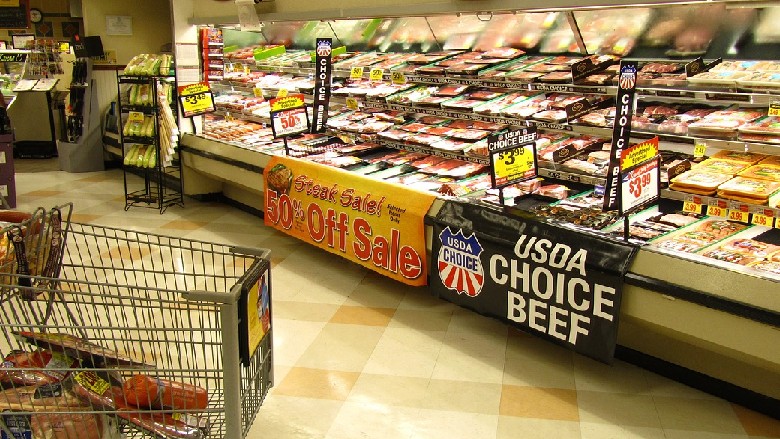2022 National Meat Case Study charts category's trajectory
NMCS finds case-ready has grown to 83% of packages and 76% of SKUs.

Anne-Marie Roerink, principal of 210 Analytics and author of the annual Power of Meat report, presented an analysis of the CRYOVAC brand 2022 National Meat Case Study.
This eighth edition of the NMCS, conducted between February and May of 2022, intends to provide an overview of meats in retail as well as trends in fresh meat. CRYOVAC conducts the NMCS every three years since 2002. This current study replaces the 2021 mini study.
The Oct. 19 webinar provided an overview of how meat is performing today.
“What we figured out, more than anything, is that, yes, the performance that we are seeing in the numbers every month in the Power of Meat are absolutely influenced by what is happening in the store, in terms of our inventory, in term of how we merchandise, to cross-merchandising, the increasing presence of non-meat items in the meat department,” Roerink said.
Roerink discusseed how meat sales exploded in 2020 and have continued to grow since then. Unit and volume sales do not compare to the dollar sales, but Roerink said that unit and volume sales are still doing well when taking industry changes into account.
Roerink said there is a lot of pressure on certain proteins, particularly chicken. Looking at the number of meat SKUs by protein type, beef and ground beef mostly held steady, while the assortment is lower for chicken, pork and turkey. She said avian influenza negatively affected the data collected, and she does not see the numbers for chicken staying on that trajectory.
Package inventory revealed similar trends, but with a few key additional areas of growth.
“Lamb also had more packages. And another area that we consistently see throughout the study that is having a big representation in the number of facings as well as the number of packages is that area that we call exotics,” Roerink said.
Moving to plant-based meat alternatives, Roerink said these products have a higher share of packages than SKUs, and the number of stores carrying alternatives in the meat case is dropping. Roerink also observes, though, that retailers are moving these items to the frozen section, and the actual number of items is currently growing.
Looking at the self-serve case, fresh meat continues to lose linear feet, but ground beef gained more space in the self-serve case share. Smaller volume proteins like lamb and bison also gained more of the share of linear feet.
The average package weight stayed fairly stable, but had an increase directly related to a greater bone-share compared to the last study. Though there was a rise of boneless, this trend is reversing. Exact-weight packages, though, increased.
“And that really was driven by turkey, by lamb, by beef. But, of course, very high representation by ground beef, as well,” Roerink said. “Now, 75% of ground beef packages are fixed weight. So that is really important to keep in mind.”
She said fixed weight has a lot to do with the case-ready situation and allows for different merchandising.
“A lot of consumers struggle with that price per pound kind of merchandising and would love to know exactly what a package is going to cost them prior to going to the store,” Roerink said. “So this exact weight allows us to do that a lot more easily.”
Case-ready has grown to 83% of packages and 76% of SKUs. Case-ready has had the most growth with turkey and chicken, but is growing overall, up from 49% in 2002. Roerink said there will be continued growth for case-ready.
Moving to packaging types, vacuum overtakes PVC wrap with the increased popularity of rollstock, saddle packs and shrink bags. Vacuum makes up 32% of meat case packages while PVC wrap makes up 28%.
“We continue to see, of course, high poultry film packaging as well because of that big representation of chicken in terms of linear feet, in terms of share of packages,” Roerink said. "And others that are coming on very strong are tray lid and map packaging as well.”
Roerink says that she would expect vacuum to continue growing. Within vacuum packaging, trayless is outpacing foam, representing 41% of packages, up from 33% in 2018.
Regarding branding, the NMCS found private-label brands continuing to grow.
Natural claims are slowly growing, though natural claims for chicken and lamb have gone down. Antibiotic-related claims also increased, up to 29% from 25% in 2018. Organic claims increased rapidly for ground beef and chicken, and Roerink said organic has shown continued growth.
“And as you can see, despite all that pressure on income, (organic) continued to grow in dollars, in units, and in pounds. And that’s something that’s very important to keep an eye on,” she said. “And it has everything to do with that organic shopper being a higher income shopper who has a little bit more discretionary income than middle and lower income who are struggling very much in today’s environment.”
Grass-fed claims are at 12%, up from 10% in 2018, which is driven by ground beef. Roerink noted that value-added meats are experiencing change, likely due to millennials.
“We know that millennials love the idea of having limited time offers, different flavors, really fun flavor profiles, sometimes matching the season, or matching something that is happening on the restaurant side,” Roerink said.
Since millennials seem to be so drawn to diverse and limited-time products, Roerink anticipates continual growth for value-added meats.
Visit http://learn.meatinstitute.org/ for more about the 2022 National Meat Case Study.
Looking for a reprint of this article?
From high-res PDFs to custom plaques, order your copy today!







